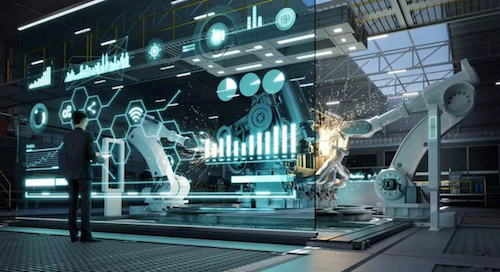Massivit 3D outlines the relationship between Industry 4.0 and additive manufacturing, exploring how this technology is driving innovation and sustainability in the manufacturing sector. The company also discusses the role of academia-industry partnerships in advancing additive manufacturing, the impact of this technology on key industries, and the challenges and opportunities that lie ahead.
Industry 4.0, also known as the Fourth Industrial Revolution, is a term that embodies the dynamic technological advancements across many sectors. From hardware, cloud connectivity, AI, and manufacturing, Industry 4.0 touches seemingly everything. Manufacturers in particular are embracing this exciting era, one that holds immense potential for them, with additive manufacturing, also known as 3D printing, leading the way as one of the most transformative technologies in Industry 4.0.
Additive manufacturing plays a pivotal role in Industry 4.0 by enabling the production of complex and customised products on demand, reducing material waste, and streamlining supply chains. This technology allows for rapid prototyping, mass customisation, and the integration of advanced materials, driving significant improvements in efficiency, cost reduction, and innovation across various industries. Additive manufacturing also aligns with the growing global focus on sustainability in the manufacturing sector, as it offers opportunities to minimise environmental impact through reduced waste, lower energy consumption, and the use of eco-friendly materials.
Key Advantages Of Additive Manufacturing In Industry 4.0
Customisation and on-demand production: additive manufacturing enables manufacturers to create bespoke products tailored to individual customer needs, providing greater flexibility and enhancing customer satisfaction.
Reduction of material waste: by using only the required material for each part, additive manufacturing significantly reduces material waste, contributing to more sustainable and cost-effective production processes.
Complex geometries and lightweight components: the technology allows for the creation of intricate designs and lightweight parts, which can enhance product performance, optimise fuel efficiency, and reduce energy consumption.
Shortened lead times and reduced inventory: additive manufacturing can accelerate production processes, enabling faster response times to changing market conditions and reducing the need for large inventories, thus lowering costs and increasing efficiency.
Localised and decentralised production: by enabling on-demand production closer to the end-user, 3D printing can reduce transportation emissions and promote more sustainable supply chains. This approach not only benefits the environment but also allows manufacturers to respond more quickly to market demands and changing customer needs.
Additive Manufacturing In Key Industries
Automotive
Additive manufacturing has gained significant traction in the automotive industry due to its ability to produce complex, lightweight components and enable customisation. Car manufacturers such as BMW and Audi have adopted 3D printing technologies for producing bespoke parts, prototypes, and even entire vehicles. These advancements have allowed for reduced lead times, increased fuel efficiency, and more streamlined production processes, ultimately contributing to a more sustainable and innovative automotive industry.
Aerospace
The aerospace industry has been an early adopter of additive manufacturing, leveraging its capabilities to create lightweight, complex components that can withstand extreme conditions. The technology allows for the production of parts with optimised geometries, leading to increased fuel efficiency and reduced emissions. Companies like Boeing and Airbus have integrated additive manufacturing into their production processes, from prototyping to manufacturing critical components, resulting in cost savings and improved overall performance.
Marine Manufacturing
In the marine industry, additive manufacturing is being used to create more efficient, lightweight, and durable components for boats, ships, and submarines. The technology allows for the production of customised parts that can withstand the harsh marine environment, leading to longer-lasting and more reliable vessels. Additionally, the ability to create complex geometries enables the development of more efficient propulsion systems, reducing fuel consumption and lowering the industry’s environmental impact.
Architecture And Design
In the realm of architecture, additive manufacturing is revolutionising the way architects and designers conceive and execute their projects. The technology enables them to create intricate, bespoke designs that were previously impossible or too costly to produce using traditional methods. By 3D printing building components, facades, or even entire structures, architects can explore new design possibilities, pushing the boundaries of creativity and functionality, while ensuring a more sustainable building process.
Construction
The construction industry is also beginning to explore the benefits of additive manufacturing, with the development of large scale 3D printers capable of producing entire buildings and infrastructure elements. The technology can be used to create complex architectural designs that would be difficult or impossible to achieve using traditional construction methods. By reducing material waste, construction times, and labour costs, additive manufacturing has the potential to revolutionise the construction industry, making it more sustainable and efficient.
Challenges And Opportunities In Additive Manufacturing
Despite its many advantages, additive manufacturing still faces technical challenges and limitations, such as size constraints, material compatibility, and post-processing requirements. There is a growing need for larger machines capable of producing bigger parts or even entire structures. However, these challenges present opportunities for further innovation and development in the additive manufacturing field, with researchers and companies continually working to improve the technology and expand its capabilities.
MASSIVIT 3D
https://massivit3d.com/















